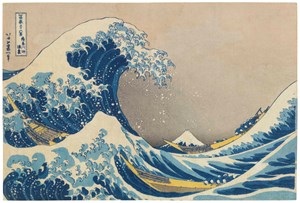KATSUSHIKA HOKUSAI (1760-1849)
KANAGAWA OKI NAMI URA (IN THE WELL OF THE GREAT WAVE OFF KANAGAWA), FROM THE SERIES FUGAKU SANJUROKKEI (THIRTY-SIX VIEWS OF MOUNT FUJI) will be offered on Christie's Japanese and Korean Art, 18 April 2018, New York.
When he was living in a cottage in Rodin’s garden and serving as private secretary to the sculptor, the poet Rainer Maria Rilke (1875–1926) discovered Hokusai. So taken by Hokusai’s Thirty-six Views of Mount Fujiand illustrated book One Hundred Views of Mount Fuji, Rilke composed Der Berg (“The Mountain,” 1906–07) in homage. “Each image at the moment it was needed,” he concludes, as much an appraisal of Hokusai’s work as evidence of an evolution in his own that was coming about by looking at art that shattered his preconceptions.
In the Well of the Wave off Kanagawa has been doing just that since it was introduced to Europe in the mid-nineteenth century––a glorious history that needs no introduction here. Exhibitions devoted to Hokusai attract record-breaking crowds on the strength of this one image among the thousands he produced. Introduced as a playful element on a beauty print he designed in his teens, waves pervade his repertoire, and antecedents for Wave off Kanagawa appear in several of his prints from the early 1800s, thirty years before this one came out around 1831. Hokusai was then in his seventies and in need of financial and artistic sustenance; his wife had died and he and his daughter–collaborator, Oi, were forced out of their home by the impecunious habits of Hokusai’s grandson. “No money, no clothes, barely enough to eat,” wrote Hokusai. The remedy: The Thirty-six Views of Mount Fuji, in which the publisher Nishimuraya Yohachi (Eijudo) saw commercial potential. It proved so successful that several editions were printed, which accounts for the variety of coloration one encounters in the blue water and sky and the black gradation above the horizon of the “Great Wave.”
Here, the gradation occupies a rough half-circle up into the arc of the wave, allowing the dots of foam to stand out more than they do in some impressions where the shading is more pronounced. The season is early spring, when the crest of Mount Fuji is saturated with snow. The time is dawn, indicated in this impression by pale pink undersides of the cumulus clouds and by the lingering darkness expressed by the charcoal hand-shading (bokashi). The waves are in three shades of blue, very pronounced in the crests. Another print with this blue scheme is in the Hagi Uragami Museum (see Yamaguchi Kenritsu Hagi Bijutsukan Uragami Kinenkan meihinten: Yakimono ga suki ukiyoe mo suki / Ceramics and Ukiyo-e: Masterpieces from the Hagi Uragami Museum [Tokyo: Nezu Museum, 2013], pl. 172). See also, “Katsushika Hokusai: The Great Wave,” series 3, episode 6 of “Private Life of a Masterpiece,” broadcast by the BBC in March 2009 and a thorough introduction to this print by a team of scholars; Hokusai is the sole non-European (Whistler counting as British) artist in the company of da Vinci, Picasso, Goya etc.
The “waves that are claws” that Van Gogh saw in this image is, as wave scientists have now explained, a series of cresting waves that end in hooks, known as fractal waves. The astonishing aspect of Hokusai’s treatment is how closely it resembles the actual wave. Experts are divided as to whether he saw one of these rogue waves or heard about one from fisherman. An essay of interest to anyone engaged with this print is accessible online: Julyan H. E. Cartwright and Nakamura Hisami, “What Kind of a Wave is Hokusai’s Great Wave Off Kanagawa,” Notes and Records of The Royal Society 63 (2009): 119–35. They, and others, pinpoint the scene as outside the mouth of Tokyo Bay in seas known for rough water. Mount Fuji is visible from this position as Hokusai has it: far away, so it looks small. The boats are heading away from Edo (Tokyo), speeding to meet fishermen with fresh catches of bonito, a springtime delicacy that sold for high prices in the capital. There are eight boatmen to skull the boats, rather than the more usual four, suggesting that they intend a round trip. Whether they manage, hunkered down over their oars, to slice through the wave like surfers or be pummeled by it is, of course, the captivating mystery of the drama.
After Hokusai, Rainer Rilke encountered Cézanne. His suite of letters, on blue paper, to his wife meditate on what Cézanne called “la realization,” the intense recognition of reality through experience, the capture of “the thing” and the thrill of nature’s ever-changing presence. Rilke believed that he has been able to recognize “the turning point” in Cézanne’s paintings, a pivot Hokusai may have understood from his own progression toward his goal of imbuing every line and every dot with a life of its own.
Image: KATSUSHIKA HOKUSAI (1760-1849)
KANAGAWA OKI NAMI URA (IN THE WELL OF THE GREAT WAVE OFF KANAGAWA), FROM THE SERIES FUGAKU SANJUROKKEI (THIRTY-SIX VIEWS OF MOUNT FUJI)
Signed Hokusai aratame Iitsu hitsu, published by Nishimuraya Yohachi (Eijudo)
9 ¾ x 14 ¾ in. (24.8 x 37.5 cm.)

